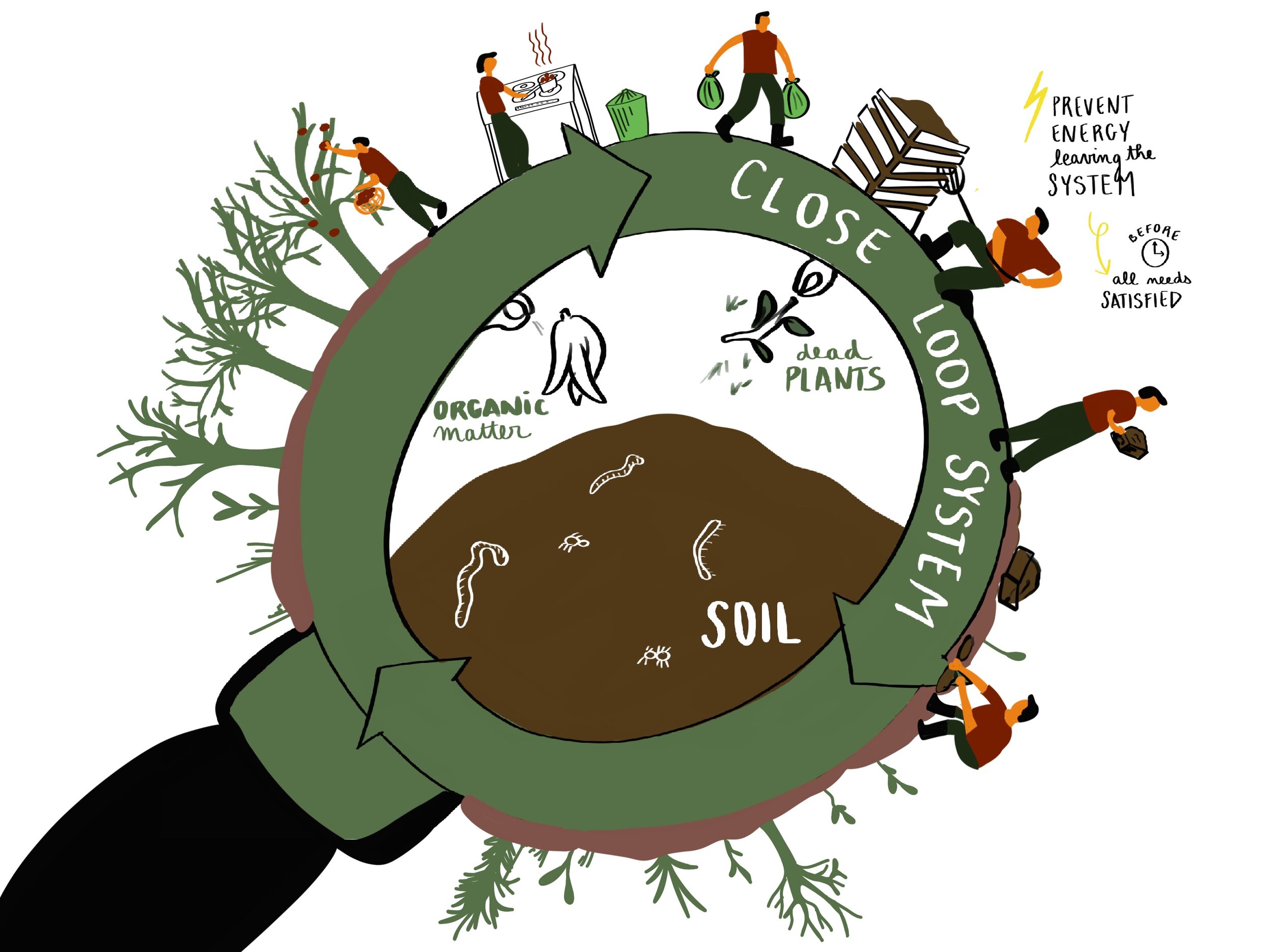Session 8: Magic of Compost
COVID-19 Community Resilience & Permaculture Course
Session 8: Magic of Composting
Why is composting so important in permaculture design?
After this session, you will
Know the basic of composting
get an idea of why composting is such an important process within permaculture
get an idea about the four main components in composting (Carbon, Nitrogen, Water, Oxygen)
Learn about Carbon Nitrogen Ration and how to manage your C:N-Ratio
get introduced to thermophilic compost, static compost, vermicompost, and anaerobic composting
Watch the video, read the text, and finish the learning exercise to complete this session of our Permaculture & Resilience free online course.
Video: Session 8 -Magic of Composting-
What is the magic of compost?
Composting is following nature, it is mimicking a natural process (decomposing organic matter) and making it accessible in a more human-centered and designed environment. A decomposing process harnessing micro and macro-organisms happen on the forest floor. Healthy and rich forest soil is created out of fallen leaves, branches, and dead trees in a slow and natural process. Decomposing happens on your garden beds, compost piles, and basically everywhere. In short, organic matter or dead plant parts are transformed into soil again and create a closed-loop-system.
“Whatever we take, we must return”
It is very important to keep the law of return in mind when setting up compost piles. When composting you are not creating additional fertility, you are accumulating organic matter and fertility at one spot. By doing so you are summing up the existing organic matter at one spot and making it available and accessible for you. However, you do not create additional fertility or organic matter you make it manageable. Composting is a very important part of turning a problem into a solution and creating no waste, and it is very beneficial for soil fertility.
Masanobu Fukuoka in the 1970 invented natural farming. He has a different perspective on composting and is basically promoting to minimize additional intake on organic matter. Instead, he prefers to work with green mulch and living ground cover plants and keeping as much as possible of the created organic matter on the growing spot. By doing so, he is mimicking the natural way of ecosystems to sustain soil fertility.
Composting and permaculture!
Our work as permaculture designers is to prevent energy from leaving the system before the basic needs of the whole system are satisfied, so that growth, reproduction, and maintenance continue in our living components. Composting is part of increasing independence from the outside system and taking responsibility for organic waste created within your ecosystem or permaculture project. Permaculture is looking for closed-loop-systems and composting is a perfect example to close the food-loop. Composting helps you to circulate energy in your system as you re-introduce kitchen scraps back into the system while turning it into soil you are afterward growing your next vegetable harvest out of. Closing the loop further would also include dealing with human disposal (urine and manure). When handled with care you have great fertilizer (urine) and good compost material (manure). You just need to understand the risks of humanure and mitigate it accordingly (Check with your local restrictions, if you are actually allowed to compost your human disposal). Besides, taking responsibility and ownership of your waste you are also increasing resilience, mitigating human impact on an ecosystem, and living with nature rather than against.
Composting in a close look system by Sketching the Move
Why should we make compost?
A compost pile helps to create a location where you collect your kitchen and garden residues. It is managing the commodity supply and gives you a spot where you can turn „waste“ into a resource. The organic share of domestic waste is around 40 to 70% depending on which country you are living in. Thus, separating potential compost material from the other waste components comes with a huge potential to decrease global waste management and is an easy first step into a low-waste-lifestyle. Instead of creating toxic landfills for waste you are actually turning it into a strongly needed resource for nature, just by following a natural close-loop-system. Besides, taking ownership it helps to manage and improve your soil condition. The final product is a rich and fertile soil as a beautiful basis to grow your own food. Adding organic matter or compost is about feeding the soil, not the plants, and promoting a healthy soil-food-web in different ways:
Improves soil structure
Improves water retention
Adds nutrients in a slow-release plant soluble form
Helps to reduce pests and diseases in the soil
Balances pH toward neutral
What are the main compost elements?
The natural process of decomposing is very simple. It is all about managing the interdependency between carbon and nitrogen (C:N ration) as well as managing water and air content. The feedback loops of a compost are very fast. If it starts to smell, it is very likely that you need to adjust water or air level. If it is getting too hot, temperature-wise, you need to add more carbon material. If your compost is not taking on heat, you properly need to increase the nitrogen content to get it started. In short, you need to manage the following 4 components: Carbon (browns) Nitrogen (greens) and Water and Oxygen
Carbon and nitrogen
Carbon (C) is the building block for life and bacteria use carbon as a food source of energy. To simplify, we call it brown material (high in carbon)
Nitrogen (N) is used by bacteria for cell development and reproduction. As nitrogen is normally in green material, we call it green material (high in nitrogen).
Carbon-nitrogen-ratio (C/N-Ratio):
For everyone that wants to dive deeper in the world of carbon and nitrogen. Every kind of organic material has its own carbon-nitrogen ratio and the sum of the different materials you are adding on your compost pile needs to end up following a specific ration for the different compost processes. While working you through the different compost methods, we will also keep an eye on the C/N ratio and also showcase easy rules of thumps if you do not want to dive too much into the biochemical process of composting your organic matter.
Water and oxygen
In order to manage moisture for some climate zones, it is recommended to cover the compost pile to ensure that you have the right amount of water. Microorganisms can only utilize organic molecules that are dissolved in water. Therefore 40% to 60% of water content is recommended. The soil microorganism needs water to live, reproduce, and decompose organic matter.
Most of the decomposing methods require oxygen (presence of air) as they use aerobic bacteria for breaking down organic matter. The static compost structure allows air to penetrate the pile and hardly any turning is needed to manage air content. The thermophilic compost (hot compost) has a higher demand in air to fasten the decomposition process and needs to be turned regularly. Anaerobic decomposition processes (no oxygen needed) are part of nature (ponds) and also used in permaculture, for example for harvesting biogas.
Different types of composting
The different types and ways of composing can be structured into 4 key methods (static, thermophilic or hot compost, anaerobic and vermicomposting)
Static Composting
Backyard composting is normally following the static composting method. It is basically filled as the waste occurs and it is not agitated, meaning flipped in-between. In order to maintain aeration during the process, it is good to mix large and small particle sizes. The static composting approach is working with the same bacterial set as in thermophilic. As the amount of nitrogen is lower and less air is accelerating the decomposition, the pile is heated up in the beginning and cools down to a more stable temperature of around 20 C for the rest of the time.Advantage:
How to set up a backyard Compost pile?
Set up the pile:
Select a dry, shady spot near a water source for your compost Add brown and green materials as they are collected. To speed up decomposing you might want to chop or chip larger pieces. Manage moisture by moisten dry materials as they are added.
Adding material in a setup pile:
Mix grass clippings and green waste into the pile and bury fruit and vegetable waste under compost material. Add some carbon material (leaves, paper) to manage C:N rationOptional: Cover top of compost with a tarp to manage moisture.
When the material at the bottom is dark and rich in color, your compost is ready to use. This usually takes anywhere between two months to two years.
Thermophilic compost pile
Hot compost, 18-day Compost, Berkeley compost, or thermophilic compost is following the same process as the static compost. However, you are creating it in one go and you are turning it after you established the pile every other day. More importantly, you need to maintain a different C:N Ratio in order to ramp up the temperature and keep it on a high level throughout the duration of decomposition. We will have an extra session with all details about hot composting. We will also explain how to turn your hot compost into your renewable water heating system.
Anaerobic Composting
Composting without the presence of oxygen for example to harvest biogas. An example of anaerobic composting for households is bokashi composting.
Vermicomposting
Vermicompost is a natural process that turns your kitchen scraps into worm cast. In the best case, you just create a healthy environment for worms in your garden, and, after a while, worms will appear. You can also speed up the process by searching in one of your existing compost piles for worms or just ask in your community if anybody is already composting with worms.
If you want to dive deeper into vermicompost have a look at one of our older posts about worm farming.
You can use your vermicompost for fostering plant growth and increasing your harvest in many ways. You can mix it with your regular compost for a homemade pottery mix and provide your seedlings with an extra portion of nutrients. Worm compost is available in small quantities, but it is stuffed with good things so that you might sprinkle it over your garden beds, to create fertile pockets for your most demanding and deserving plants. You can also use it to start a compost tea that multiplies the microorganisms and spread the tea on your soil or as pest control on your plants.
Composting in short
Composting is following the main permaculture principles turning waste into a resource and creating rich and healthy soil components in a very simple way. It will strengthen your soil-food-web and increase your growth and yield of your ecosystem.
Learning exercise
Today’s learning exercise is about research. What would be an ideal placement for a compost? Keep the previous sessions in mind but also have a look at what are the requirements of compost with regards to the sun, water, etc. Please share your thoughts with us.





